Corporate Law Report: Liabilities, Fiduciary Duty, and Advice
VerifiedAdded on 2022/10/04
|11
|2481
|48
Report
AI Summary
This report provides a comprehensive analysis of corporate law, examining the liabilities of companies and partnerships towards third parties. It differentiates between the legal structures, highlighting the implications of actions by partners and directors, and the concept of lifting the corporate veil. The report further explores the fiduciary duties of company directors and partners, detailing their obligations under the Corporations Act 2001 and common law, including the duty of care, good faith, and avoidance of conflicts of interest. It also includes a case study on ASIC v Vizard, offering advice to clients on director responsibilities and corporate governance, referencing relevant sections of the Act and legal precedents. The report emphasizes the importance of understanding legal obligations for both companies and partnerships.
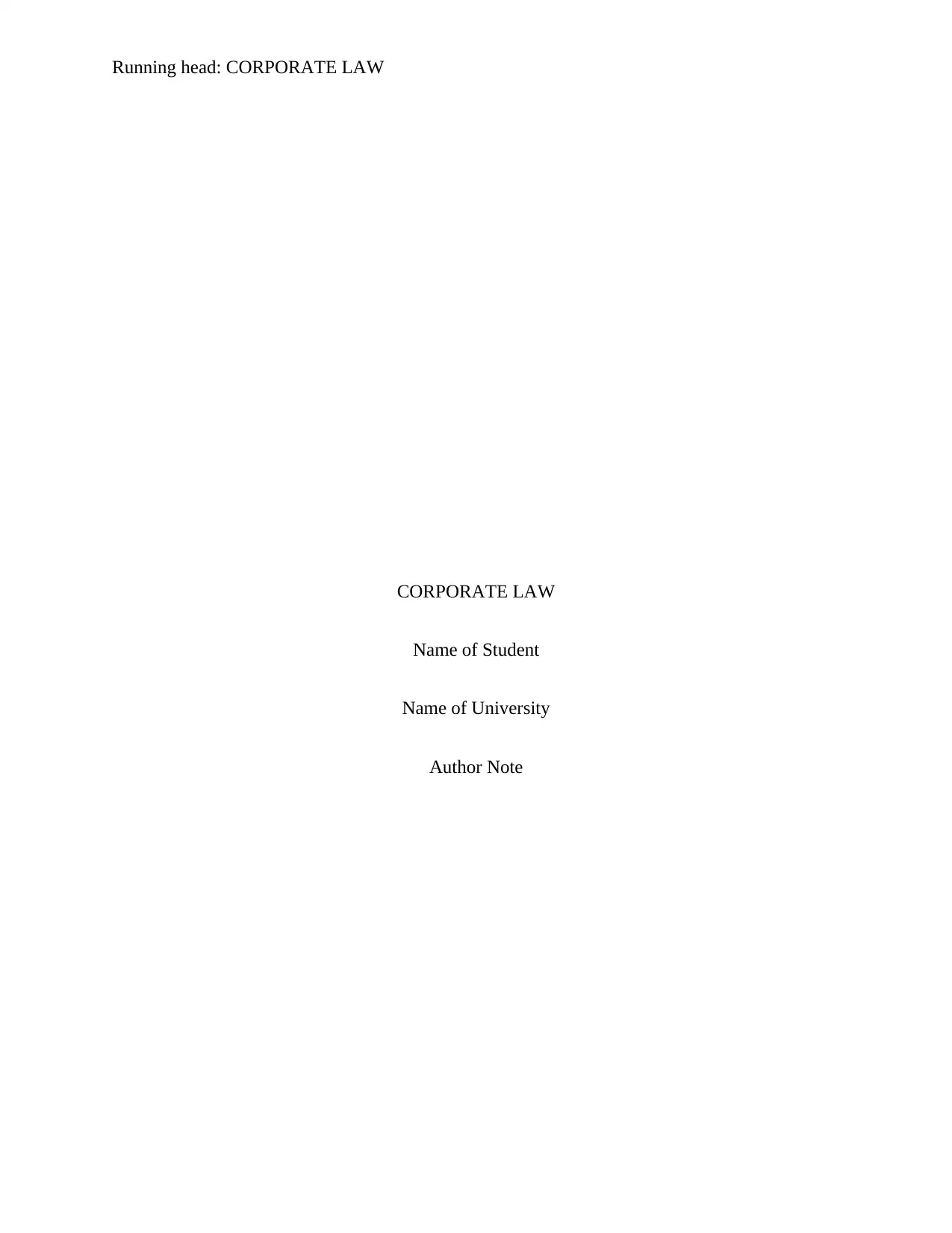
Running head: CORPORATE LAW
CORPORATE LAW
Name of Student
Name of University
Author Note
CORPORATE LAW
Name of Student
Name of University
Author Note
Paraphrase This Document
Need a fresh take? Get an instant paraphrase of this document with our AI Paraphraser
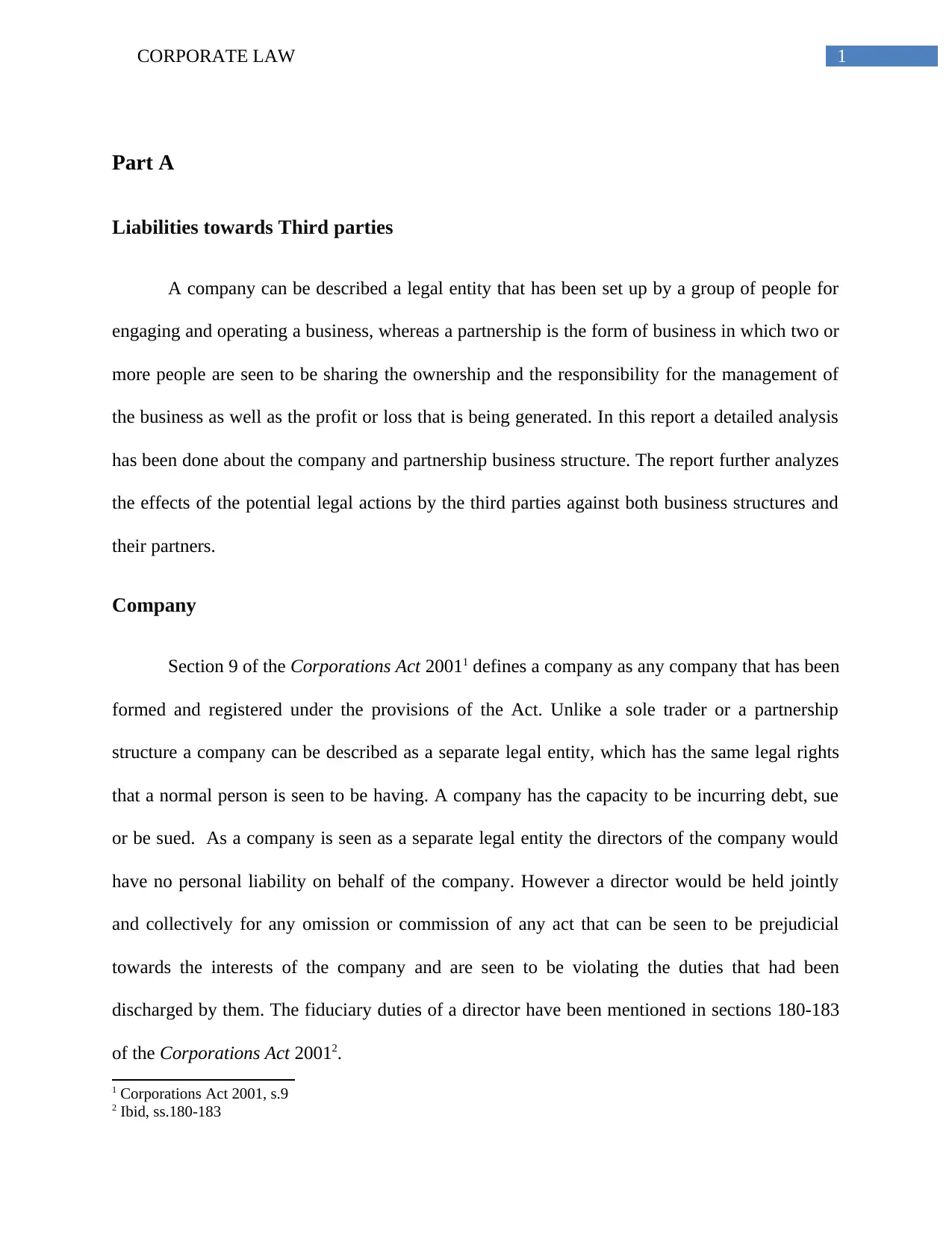
1CORPORATE LAW
Part A
Liabilities towards Third parties
A company can be described a legal entity that has been set up by a group of people for
engaging and operating a business, whereas a partnership is the form of business in which two or
more people are seen to be sharing the ownership and the responsibility for the management of
the business as well as the profit or loss that is being generated. In this report a detailed analysis
has been done about the company and partnership business structure. The report further analyzes
the effects of the potential legal actions by the third parties against both business structures and
their partners.
Company
Section 9 of the Corporations Act 20011 defines a company as any company that has been
formed and registered under the provisions of the Act. Unlike a sole trader or a partnership
structure a company can be described as a separate legal entity, which has the same legal rights
that a normal person is seen to be having. A company has the capacity to be incurring debt, sue
or be sued. As a company is seen as a separate legal entity the directors of the company would
have no personal liability on behalf of the company. However a director would be held jointly
and collectively for any omission or commission of any act that can be seen to be prejudicial
towards the interests of the company and are seen to be violating the duties that had been
discharged by them. The fiduciary duties of a director have been mentioned in sections 180-183
of the Corporations Act 20012.
1 Corporations Act 2001, s.9
2 Ibid, ss.180-183
Part A
Liabilities towards Third parties
A company can be described a legal entity that has been set up by a group of people for
engaging and operating a business, whereas a partnership is the form of business in which two or
more people are seen to be sharing the ownership and the responsibility for the management of
the business as well as the profit or loss that is being generated. In this report a detailed analysis
has been done about the company and partnership business structure. The report further analyzes
the effects of the potential legal actions by the third parties against both business structures and
their partners.
Company
Section 9 of the Corporations Act 20011 defines a company as any company that has been
formed and registered under the provisions of the Act. Unlike a sole trader or a partnership
structure a company can be described as a separate legal entity, which has the same legal rights
that a normal person is seen to be having. A company has the capacity to be incurring debt, sue
or be sued. As a company is seen as a separate legal entity the directors of the company would
have no personal liability on behalf of the company. However a director would be held jointly
and collectively for any omission or commission of any act that can be seen to be prejudicial
towards the interests of the company and are seen to be violating the duties that had been
discharged by them. The fiduciary duties of a director have been mentioned in sections 180-183
of the Corporations Act 20012.
1 Corporations Act 2001, s.9
2 Ibid, ss.180-183
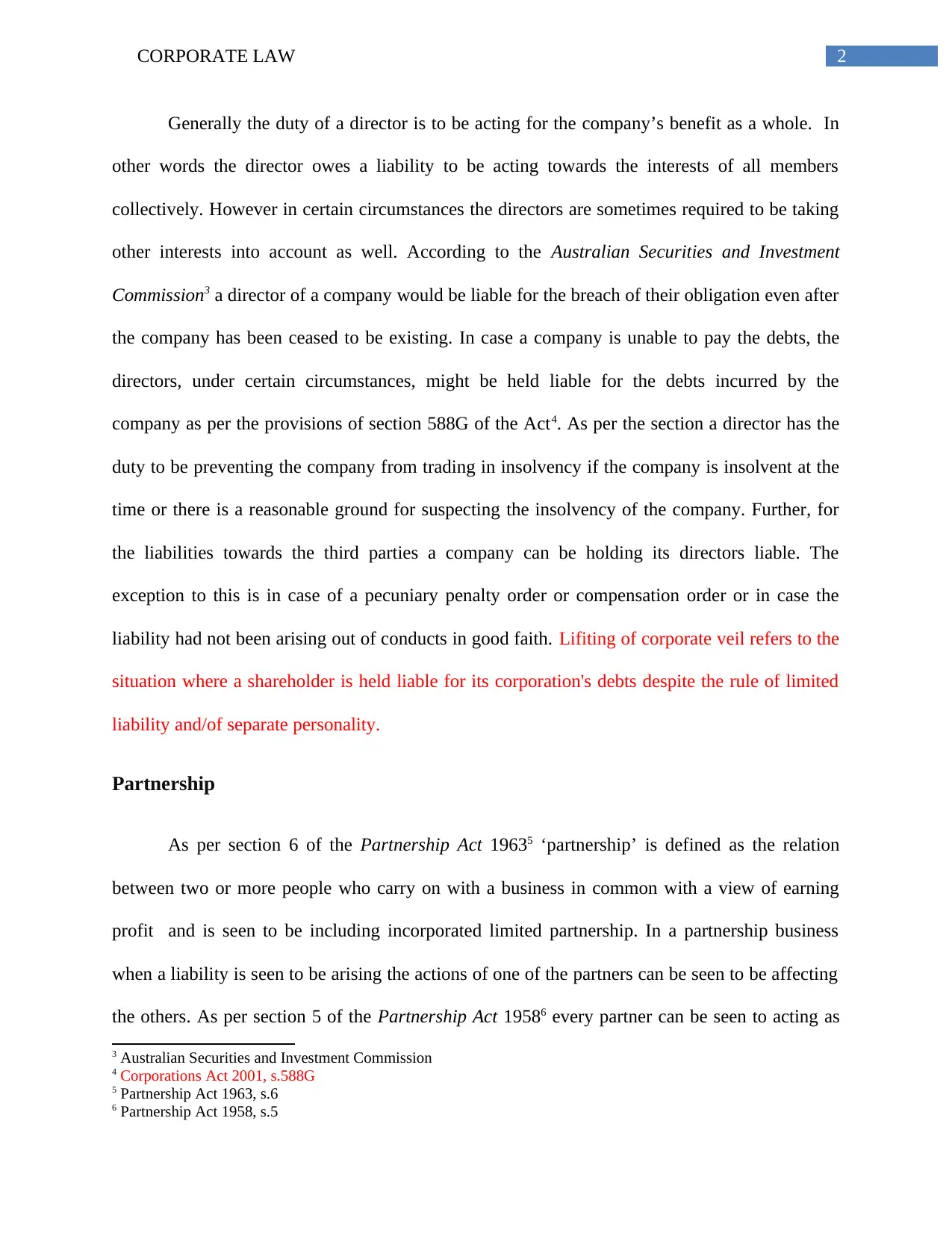
2CORPORATE LAW
Generally the duty of a director is to be acting for the company’s benefit as a whole. In
other words the director owes a liability to be acting towards the interests of all members
collectively. However in certain circumstances the directors are sometimes required to be taking
other interests into account as well. According to the Australian Securities and Investment
Commission3 a director of a company would be liable for the breach of their obligation even after
the company has been ceased to be existing. In case a company is unable to pay the debts, the
directors, under certain circumstances, might be held liable for the debts incurred by the
company as per the provisions of section 588G of the Act4. As per the section a director has the
duty to be preventing the company from trading in insolvency if the company is insolvent at the
time or there is a reasonable ground for suspecting the insolvency of the company. Further, for
the liabilities towards the third parties a company can be holding its directors liable. The
exception to this is in case of a pecuniary penalty order or compensation order or in case the
liability had not been arising out of conducts in good faith. Lifiting of corporate veil refers to the
situation where a shareholder is held liable for its corporation's debts despite the rule of limited
liability and/of separate personality.
Partnership
As per section 6 of the Partnership Act 19635 ‘partnership’ is defined as the relation
between two or more people who carry on with a business in common with a view of earning
profit and is seen to be including incorporated limited partnership. In a partnership business
when a liability is seen to be arising the actions of one of the partners can be seen to be affecting
the others. As per section 5 of the Partnership Act 19586 every partner can be seen to acting as
3 Australian Securities and Investment Commission
4 Corporations Act 2001, s.588G
5 Partnership Act 1963, s.6
6 Partnership Act 1958, s.5
Generally the duty of a director is to be acting for the company’s benefit as a whole. In
other words the director owes a liability to be acting towards the interests of all members
collectively. However in certain circumstances the directors are sometimes required to be taking
other interests into account as well. According to the Australian Securities and Investment
Commission3 a director of a company would be liable for the breach of their obligation even after
the company has been ceased to be existing. In case a company is unable to pay the debts, the
directors, under certain circumstances, might be held liable for the debts incurred by the
company as per the provisions of section 588G of the Act4. As per the section a director has the
duty to be preventing the company from trading in insolvency if the company is insolvent at the
time or there is a reasonable ground for suspecting the insolvency of the company. Further, for
the liabilities towards the third parties a company can be holding its directors liable. The
exception to this is in case of a pecuniary penalty order or compensation order or in case the
liability had not been arising out of conducts in good faith. Lifiting of corporate veil refers to the
situation where a shareholder is held liable for its corporation's debts despite the rule of limited
liability and/of separate personality.
Partnership
As per section 6 of the Partnership Act 19635 ‘partnership’ is defined as the relation
between two or more people who carry on with a business in common with a view of earning
profit and is seen to be including incorporated limited partnership. In a partnership business
when a liability is seen to be arising the actions of one of the partners can be seen to be affecting
the others. As per section 5 of the Partnership Act 19586 every partner can be seen to acting as
3 Australian Securities and Investment Commission
4 Corporations Act 2001, s.588G
5 Partnership Act 1963, s.6
6 Partnership Act 1958, s.5
⊘ This is a preview!⊘
Do you want full access?
Subscribe today to unlock all pages.

Trusted by 1+ million students worldwide
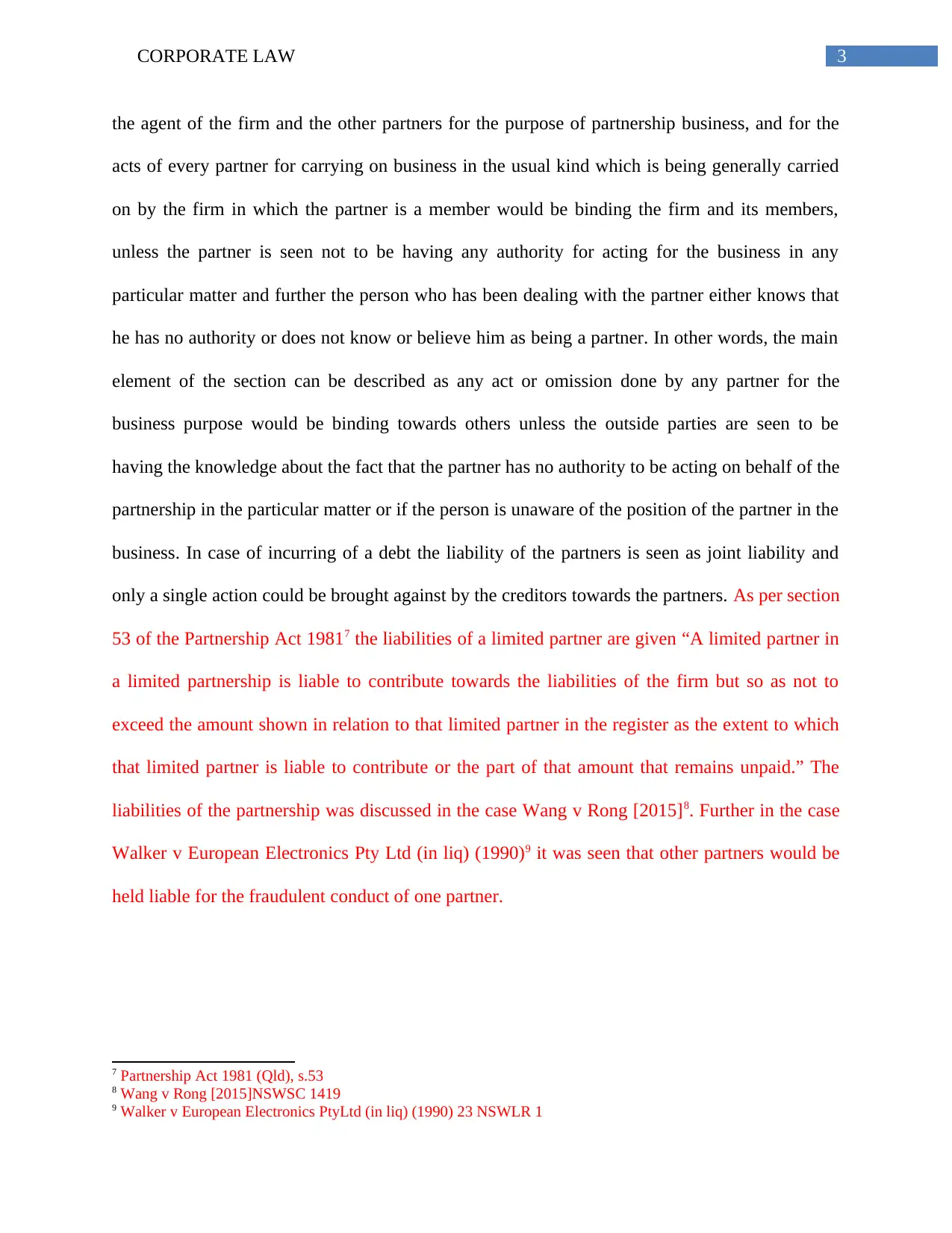
3CORPORATE LAW
the agent of the firm and the other partners for the purpose of partnership business, and for the
acts of every partner for carrying on business in the usual kind which is being generally carried
on by the firm in which the partner is a member would be binding the firm and its members,
unless the partner is seen not to be having any authority for acting for the business in any
particular matter and further the person who has been dealing with the partner either knows that
he has no authority or does not know or believe him as being a partner. In other words, the main
element of the section can be described as any act or omission done by any partner for the
business purpose would be binding towards others unless the outside parties are seen to be
having the knowledge about the fact that the partner has no authority to be acting on behalf of the
partnership in the particular matter or if the person is unaware of the position of the partner in the
business. In case of incurring of a debt the liability of the partners is seen as joint liability and
only a single action could be brought against by the creditors towards the partners. As per section
53 of the Partnership Act 19817 the liabilities of a limited partner are given “A limited partner in
a limited partnership is liable to contribute towards the liabilities of the firm but so as not to
exceed the amount shown in relation to that limited partner in the register as the extent to which
that limited partner is liable to contribute or the part of that amount that remains unpaid.” The
liabilities of the partnership was discussed in the case Wang v Rong [2015]8. Further in the case
Walker v European Electronics Pty Ltd (in liq) (1990)9 it was seen that other partners would be
held liable for the fraudulent conduct of one partner.
7 Partnership Act 1981 (Qld), s.53
8 Wang v Rong [2015]NSWSC 1419
9 Walker v European Electronics PtyLtd (in liq) (1990) 23 NSWLR 1
the agent of the firm and the other partners for the purpose of partnership business, and for the
acts of every partner for carrying on business in the usual kind which is being generally carried
on by the firm in which the partner is a member would be binding the firm and its members,
unless the partner is seen not to be having any authority for acting for the business in any
particular matter and further the person who has been dealing with the partner either knows that
he has no authority or does not know or believe him as being a partner. In other words, the main
element of the section can be described as any act or omission done by any partner for the
business purpose would be binding towards others unless the outside parties are seen to be
having the knowledge about the fact that the partner has no authority to be acting on behalf of the
partnership in the particular matter or if the person is unaware of the position of the partner in the
business. In case of incurring of a debt the liability of the partners is seen as joint liability and
only a single action could be brought against by the creditors towards the partners. As per section
53 of the Partnership Act 19817 the liabilities of a limited partner are given “A limited partner in
a limited partnership is liable to contribute towards the liabilities of the firm but so as not to
exceed the amount shown in relation to that limited partner in the register as the extent to which
that limited partner is liable to contribute or the part of that amount that remains unpaid.” The
liabilities of the partnership was discussed in the case Wang v Rong [2015]8. Further in the case
Walker v European Electronics Pty Ltd (in liq) (1990)9 it was seen that other partners would be
held liable for the fraudulent conduct of one partner.
7 Partnership Act 1981 (Qld), s.53
8 Wang v Rong [2015]NSWSC 1419
9 Walker v European Electronics PtyLtd (in liq) (1990) 23 NSWLR 1
Paraphrase This Document
Need a fresh take? Get an instant paraphrase of this document with our AI Paraphraser
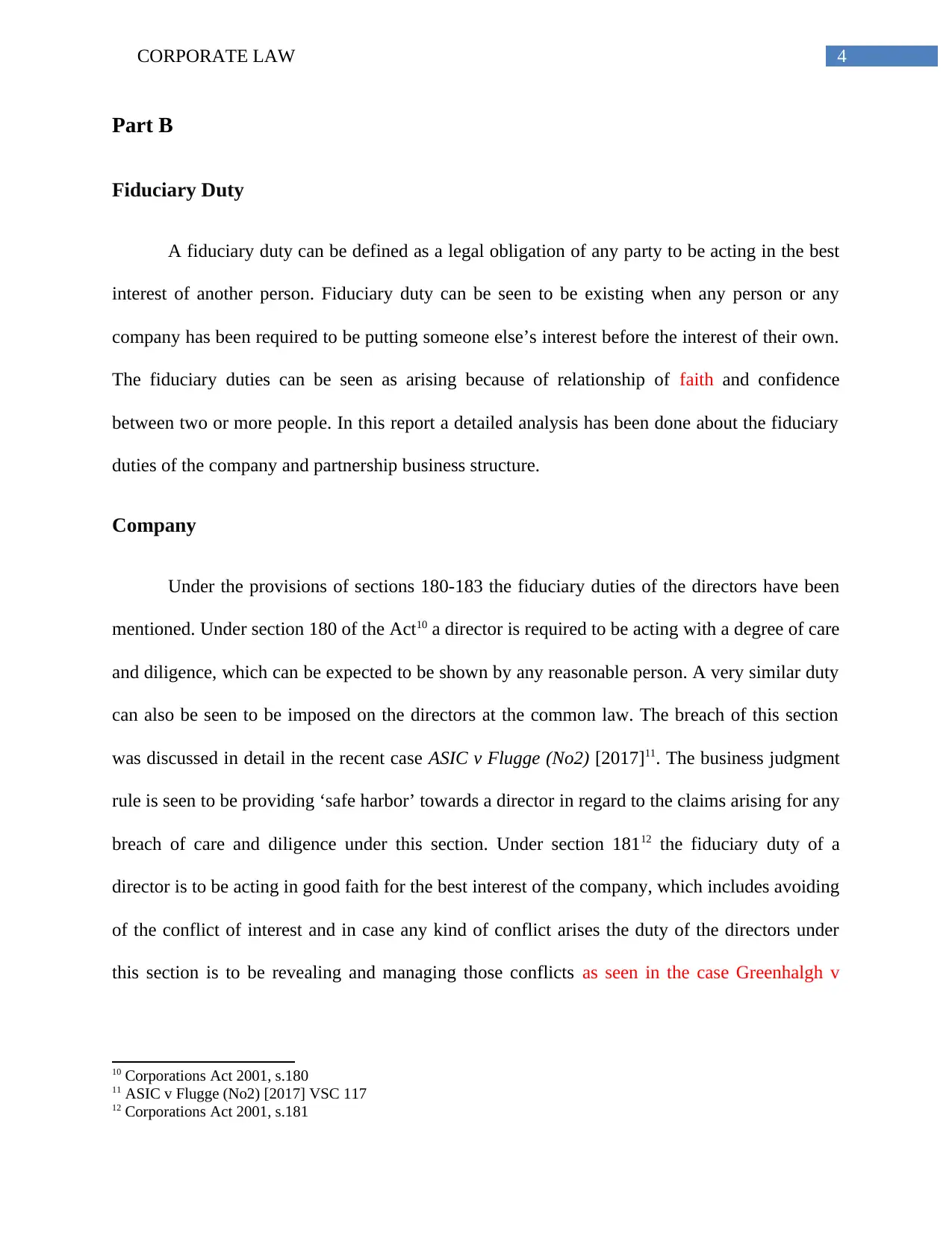
4CORPORATE LAW
Part B
Fiduciary Duty
A fiduciary duty can be defined as a legal obligation of any party to be acting in the best
interest of another person. Fiduciary duty can be seen to be existing when any person or any
company has been required to be putting someone else’s interest before the interest of their own.
The fiduciary duties can be seen as arising because of relationship of faith and confidence
between two or more people. In this report a detailed analysis has been done about the fiduciary
duties of the company and partnership business structure.
Company
Under the provisions of sections 180-183 the fiduciary duties of the directors have been
mentioned. Under section 180 of the Act10 a director is required to be acting with a degree of care
and diligence, which can be expected to be shown by any reasonable person. A very similar duty
can also be seen to be imposed on the directors at the common law. The breach of this section
was discussed in detail in the recent case ASIC v Flugge (No2) [2017]11. The business judgment
rule is seen to be providing ‘safe harbor’ towards a director in regard to the claims arising for any
breach of care and diligence under this section. Under section 18112 the fiduciary duty of a
director is to be acting in good faith for the best interest of the company, which includes avoiding
of the conflict of interest and in case any kind of conflict arises the duty of the directors under
this section is to be revealing and managing those conflicts as seen in the case Greenhalgh v
10 Corporations Act 2001, s.180
11 ASIC v Flugge (No2) [2017] VSC 117
12 Corporations Act 2001, s.181
Part B
Fiduciary Duty
A fiduciary duty can be defined as a legal obligation of any party to be acting in the best
interest of another person. Fiduciary duty can be seen to be existing when any person or any
company has been required to be putting someone else’s interest before the interest of their own.
The fiduciary duties can be seen as arising because of relationship of faith and confidence
between two or more people. In this report a detailed analysis has been done about the fiduciary
duties of the company and partnership business structure.
Company
Under the provisions of sections 180-183 the fiduciary duties of the directors have been
mentioned. Under section 180 of the Act10 a director is required to be acting with a degree of care
and diligence, which can be expected to be shown by any reasonable person. A very similar duty
can also be seen to be imposed on the directors at the common law. The breach of this section
was discussed in detail in the recent case ASIC v Flugge (No2) [2017]11. The business judgment
rule is seen to be providing ‘safe harbor’ towards a director in regard to the claims arising for any
breach of care and diligence under this section. Under section 18112 the fiduciary duty of a
director is to be acting in good faith for the best interest of the company, which includes avoiding
of the conflict of interest and in case any kind of conflict arises the duty of the directors under
this section is to be revealing and managing those conflicts as seen in the case Greenhalgh v
10 Corporations Act 2001, s.180
11 ASIC v Flugge (No2) [2017] VSC 117
12 Corporations Act 2001, s.181
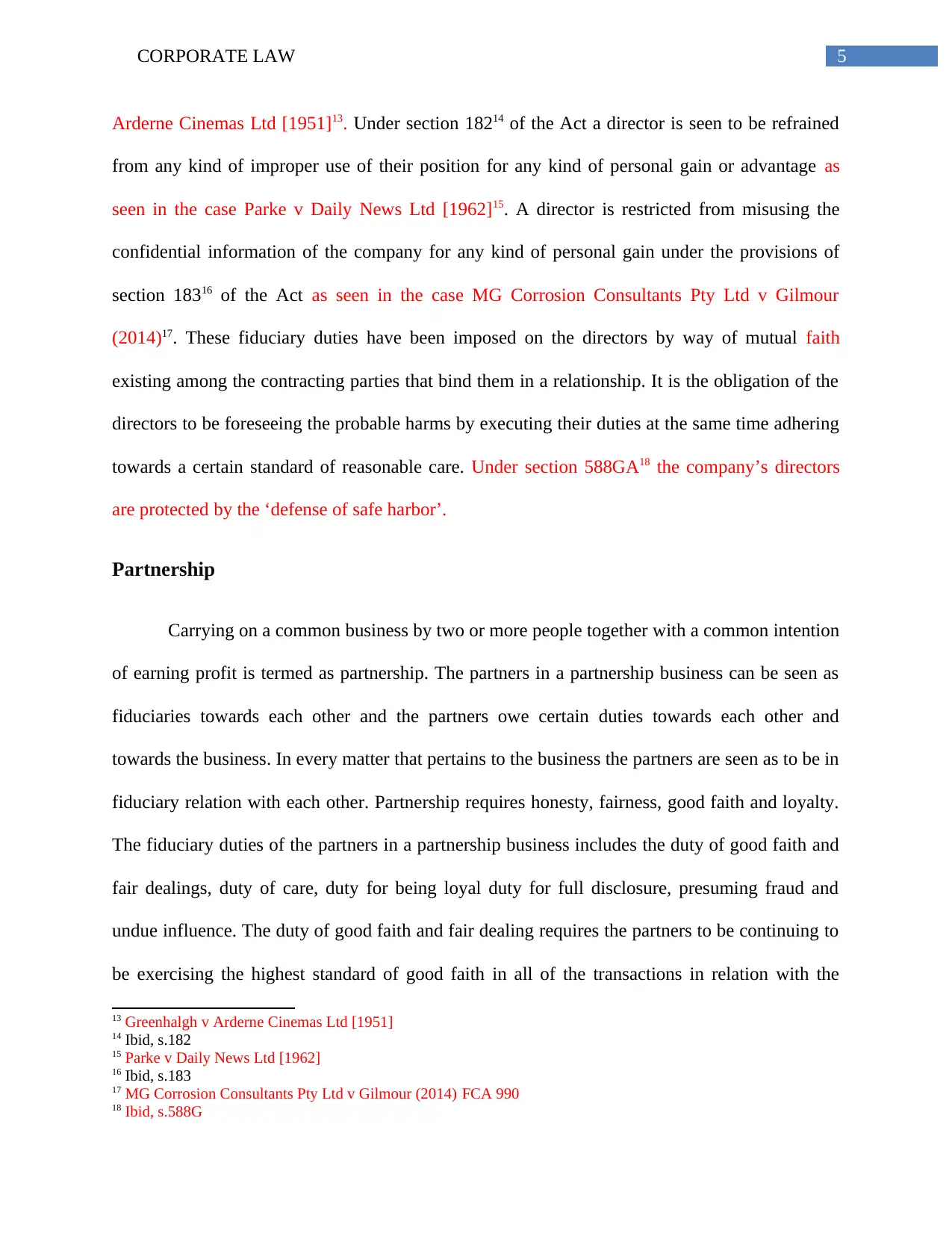
5CORPORATE LAW
Arderne Cinemas Ltd [1951]13. Under section 18214 of the Act a director is seen to be refrained
from any kind of improper use of their position for any kind of personal gain or advantage as
seen in the case Parke v Daily News Ltd [1962]15. A director is restricted from misusing the
confidential information of the company for any kind of personal gain under the provisions of
section 18316 of the Act as seen in the case MG Corrosion Consultants Pty Ltd v Gilmour
(2014)17. These fiduciary duties have been imposed on the directors by way of mutual faith
existing among the contracting parties that bind them in a relationship. It is the obligation of the
directors to be foreseeing the probable harms by executing their duties at the same time adhering
towards a certain standard of reasonable care. Under section 588GA18 the company’s directors
are protected by the ‘defense of safe harbor’.
Partnership
Carrying on a common business by two or more people together with a common intention
of earning profit is termed as partnership. The partners in a partnership business can be seen as
fiduciaries towards each other and the partners owe certain duties towards each other and
towards the business. In every matter that pertains to the business the partners are seen as to be in
fiduciary relation with each other. Partnership requires honesty, fairness, good faith and loyalty.
The fiduciary duties of the partners in a partnership business includes the duty of good faith and
fair dealings, duty of care, duty for being loyal duty for full disclosure, presuming fraud and
undue influence. The duty of good faith and fair dealing requires the partners to be continuing to
be exercising the highest standard of good faith in all of the transactions in relation with the
13 Greenhalgh v Arderne Cinemas Ltd [1951]
14 Ibid, s.182
15 Parke v Daily News Ltd [1962]
16 Ibid, s.183
17 MG Corrosion Consultants Pty Ltd v Gilmour (2014) FCA 990
18 Ibid, s.588G
Arderne Cinemas Ltd [1951]13. Under section 18214 of the Act a director is seen to be refrained
from any kind of improper use of their position for any kind of personal gain or advantage as
seen in the case Parke v Daily News Ltd [1962]15. A director is restricted from misusing the
confidential information of the company for any kind of personal gain under the provisions of
section 18316 of the Act as seen in the case MG Corrosion Consultants Pty Ltd v Gilmour
(2014)17. These fiduciary duties have been imposed on the directors by way of mutual faith
existing among the contracting parties that bind them in a relationship. It is the obligation of the
directors to be foreseeing the probable harms by executing their duties at the same time adhering
towards a certain standard of reasonable care. Under section 588GA18 the company’s directors
are protected by the ‘defense of safe harbor’.
Partnership
Carrying on a common business by two or more people together with a common intention
of earning profit is termed as partnership. The partners in a partnership business can be seen as
fiduciaries towards each other and the partners owe certain duties towards each other and
towards the business. In every matter that pertains to the business the partners are seen as to be in
fiduciary relation with each other. Partnership requires honesty, fairness, good faith and loyalty.
The fiduciary duties of the partners in a partnership business includes the duty of good faith and
fair dealings, duty of care, duty for being loyal duty for full disclosure, presuming fraud and
undue influence. The duty of good faith and fair dealing requires the partners to be continuing to
be exercising the highest standard of good faith in all of the transactions in relation with the
13 Greenhalgh v Arderne Cinemas Ltd [1951]
14 Ibid, s.182
15 Parke v Daily News Ltd [1962]
16 Ibid, s.183
17 MG Corrosion Consultants Pty Ltd v Gilmour (2014) FCA 990
18 Ibid, s.588G
⊘ This is a preview!⊘
Do you want full access?
Subscribe today to unlock all pages.

Trusted by 1+ million students worldwide
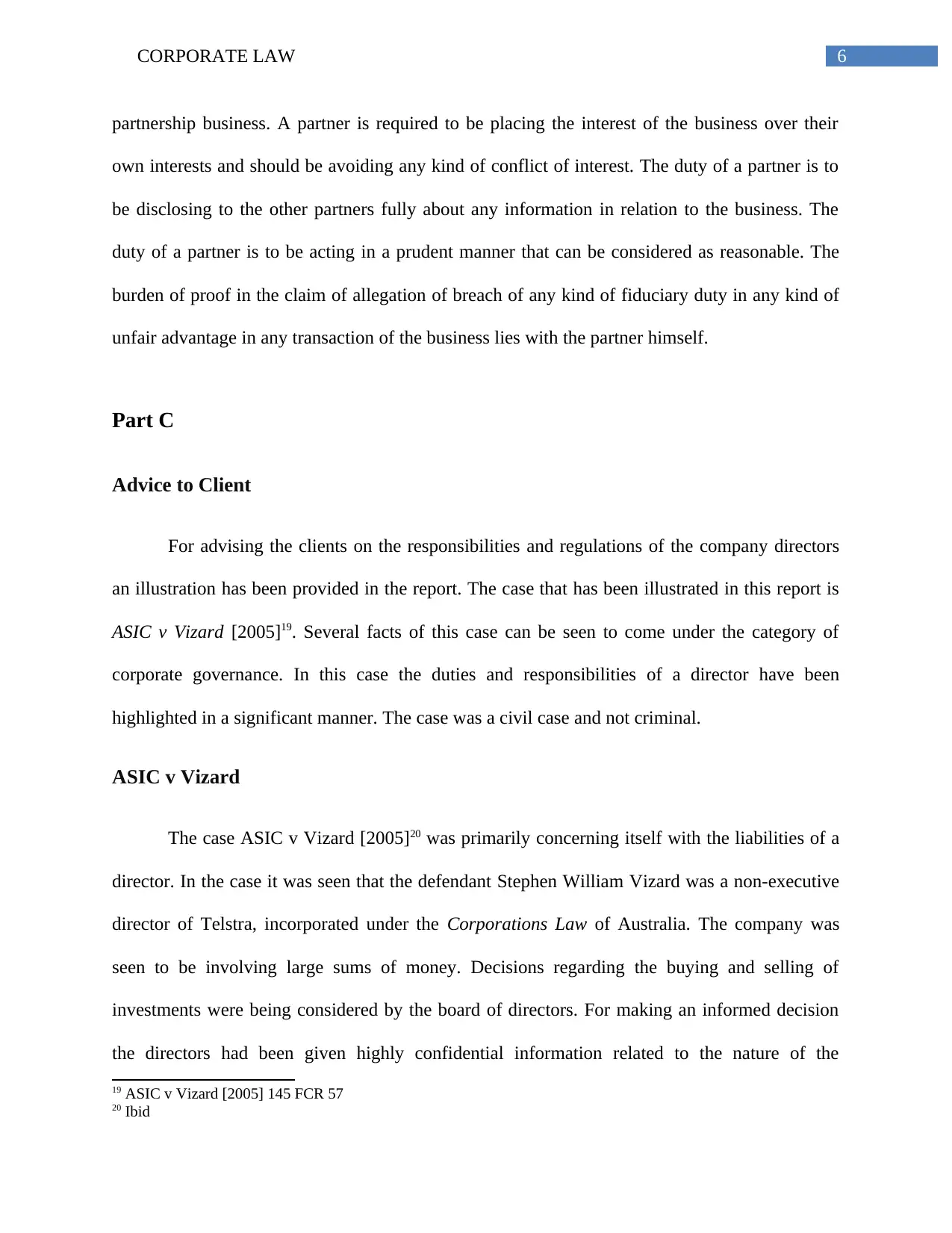
6CORPORATE LAW
partnership business. A partner is required to be placing the interest of the business over their
own interests and should be avoiding any kind of conflict of interest. The duty of a partner is to
be disclosing to the other partners fully about any information in relation to the business. The
duty of a partner is to be acting in a prudent manner that can be considered as reasonable. The
burden of proof in the claim of allegation of breach of any kind of fiduciary duty in any kind of
unfair advantage in any transaction of the business lies with the partner himself.
Part C
Advice to Client
For advising the clients on the responsibilities and regulations of the company directors
an illustration has been provided in the report. The case that has been illustrated in this report is
ASIC v Vizard [2005]19. Several facts of this case can be seen to come under the category of
corporate governance. In this case the duties and responsibilities of a director have been
highlighted in a significant manner. The case was a civil case and not criminal.
ASIC v Vizard
The case ASIC v Vizard [2005]20 was primarily concerning itself with the liabilities of a
director. In the case it was seen that the defendant Stephen William Vizard was a non-executive
director of Telstra, incorporated under the Corporations Law of Australia. The company was
seen to be involving large sums of money. Decisions regarding the buying and selling of
investments were being considered by the board of directors. For making an informed decision
the directors had been given highly confidential information related to the nature of the
19 ASIC v Vizard [2005] 145 FCR 57
20 Ibid
partnership business. A partner is required to be placing the interest of the business over their
own interests and should be avoiding any kind of conflict of interest. The duty of a partner is to
be disclosing to the other partners fully about any information in relation to the business. The
duty of a partner is to be acting in a prudent manner that can be considered as reasonable. The
burden of proof in the claim of allegation of breach of any kind of fiduciary duty in any kind of
unfair advantage in any transaction of the business lies with the partner himself.
Part C
Advice to Client
For advising the clients on the responsibilities and regulations of the company directors
an illustration has been provided in the report. The case that has been illustrated in this report is
ASIC v Vizard [2005]19. Several facts of this case can be seen to come under the category of
corporate governance. In this case the duties and responsibilities of a director have been
highlighted in a significant manner. The case was a civil case and not criminal.
ASIC v Vizard
The case ASIC v Vizard [2005]20 was primarily concerning itself with the liabilities of a
director. In the case it was seen that the defendant Stephen William Vizard was a non-executive
director of Telstra, incorporated under the Corporations Law of Australia. The company was
seen to be involving large sums of money. Decisions regarding the buying and selling of
investments were being considered by the board of directors. For making an informed decision
the directors had been given highly confidential information related to the nature of the
19 ASIC v Vizard [2005] 145 FCR 57
20 Ibid
Paraphrase This Document
Need a fresh take? Get an instant paraphrase of this document with our AI Paraphraser
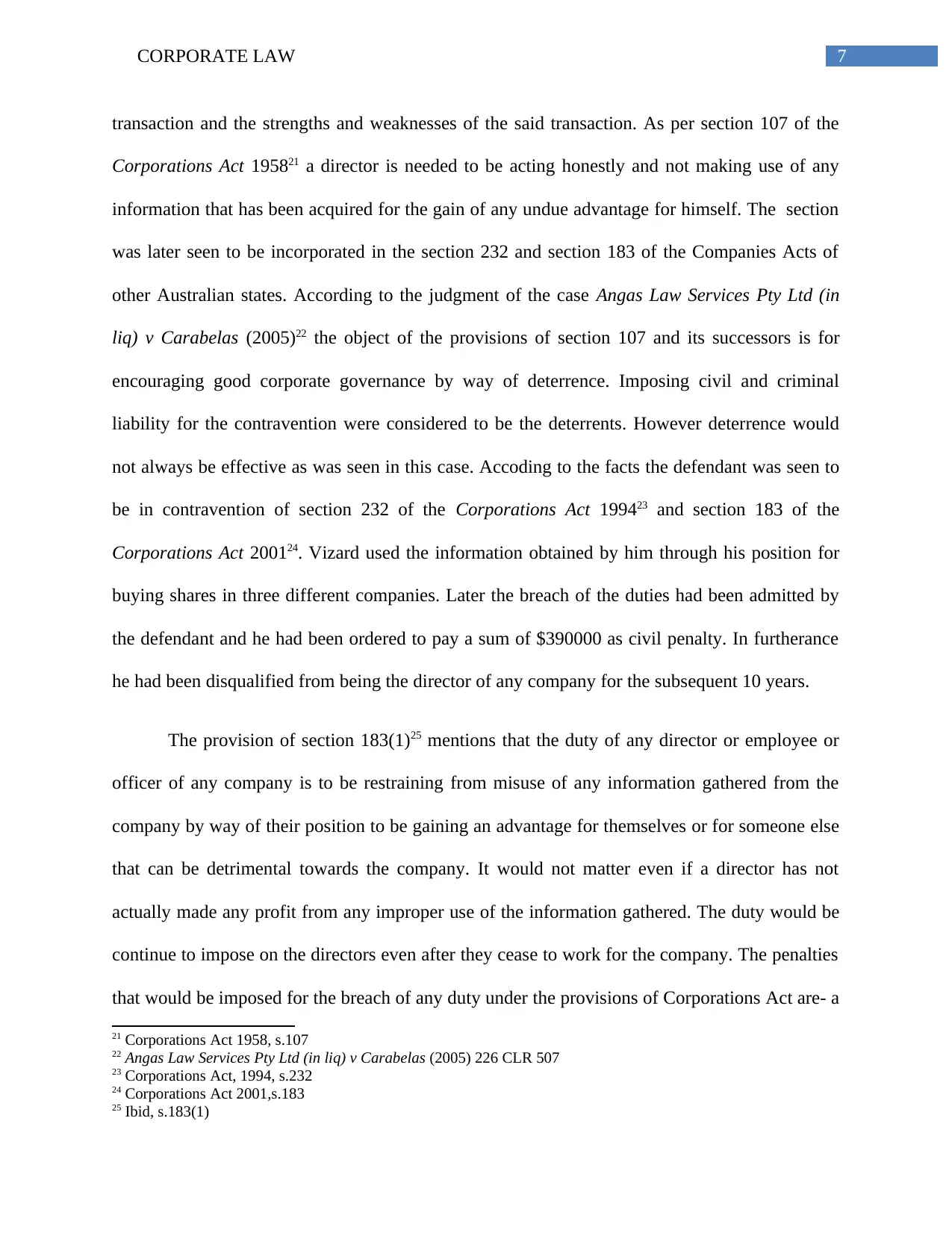
7CORPORATE LAW
transaction and the strengths and weaknesses of the said transaction. As per section 107 of the
Corporations Act 195821 a director is needed to be acting honestly and not making use of any
information that has been acquired for the gain of any undue advantage for himself. The section
was later seen to be incorporated in the section 232 and section 183 of the Companies Acts of
other Australian states. According to the judgment of the case Angas Law Services Pty Ltd (in
liq) v Carabelas (2005)22 the object of the provisions of section 107 and its successors is for
encouraging good corporate governance by way of deterrence. Imposing civil and criminal
liability for the contravention were considered to be the deterrents. However deterrence would
not always be effective as was seen in this case. Accoding to the facts the defendant was seen to
be in contravention of section 232 of the Corporations Act 199423 and section 183 of the
Corporations Act 200124. Vizard used the information obtained by him through his position for
buying shares in three different companies. Later the breach of the duties had been admitted by
the defendant and he had been ordered to pay a sum of $390000 as civil penalty. In furtherance
he had been disqualified from being the director of any company for the subsequent 10 years.
The provision of section 183(1)25 mentions that the duty of any director or employee or
officer of any company is to be restraining from misuse of any information gathered from the
company by way of their position to be gaining an advantage for themselves or for someone else
that can be detrimental towards the company. It would not matter even if a director has not
actually made any profit from any improper use of the information gathered. The duty would be
continue to impose on the directors even after they cease to work for the company. The penalties
that would be imposed for the breach of any duty under the provisions of Corporations Act are- a
21 Corporations Act 1958, s.107
22 Angas Law Services Pty Ltd (in liq) v Carabelas (2005) 226 CLR 507
23 Corporations Act, 1994, s.232
24 Corporations Act 2001,s.183
25 Ibid, s.183(1)
transaction and the strengths and weaknesses of the said transaction. As per section 107 of the
Corporations Act 195821 a director is needed to be acting honestly and not making use of any
information that has been acquired for the gain of any undue advantage for himself. The section
was later seen to be incorporated in the section 232 and section 183 of the Companies Acts of
other Australian states. According to the judgment of the case Angas Law Services Pty Ltd (in
liq) v Carabelas (2005)22 the object of the provisions of section 107 and its successors is for
encouraging good corporate governance by way of deterrence. Imposing civil and criminal
liability for the contravention were considered to be the deterrents. However deterrence would
not always be effective as was seen in this case. Accoding to the facts the defendant was seen to
be in contravention of section 232 of the Corporations Act 199423 and section 183 of the
Corporations Act 200124. Vizard used the information obtained by him through his position for
buying shares in three different companies. Later the breach of the duties had been admitted by
the defendant and he had been ordered to pay a sum of $390000 as civil penalty. In furtherance
he had been disqualified from being the director of any company for the subsequent 10 years.
The provision of section 183(1)25 mentions that the duty of any director or employee or
officer of any company is to be restraining from misuse of any information gathered from the
company by way of their position to be gaining an advantage for themselves or for someone else
that can be detrimental towards the company. It would not matter even if a director has not
actually made any profit from any improper use of the information gathered. The duty would be
continue to impose on the directors even after they cease to work for the company. The penalties
that would be imposed for the breach of any duty under the provisions of Corporations Act are- a
21 Corporations Act 1958, s.107
22 Angas Law Services Pty Ltd (in liq) v Carabelas (2005) 226 CLR 507
23 Corporations Act, 1994, s.232
24 Corporations Act 2001,s.183
25 Ibid, s.183(1)
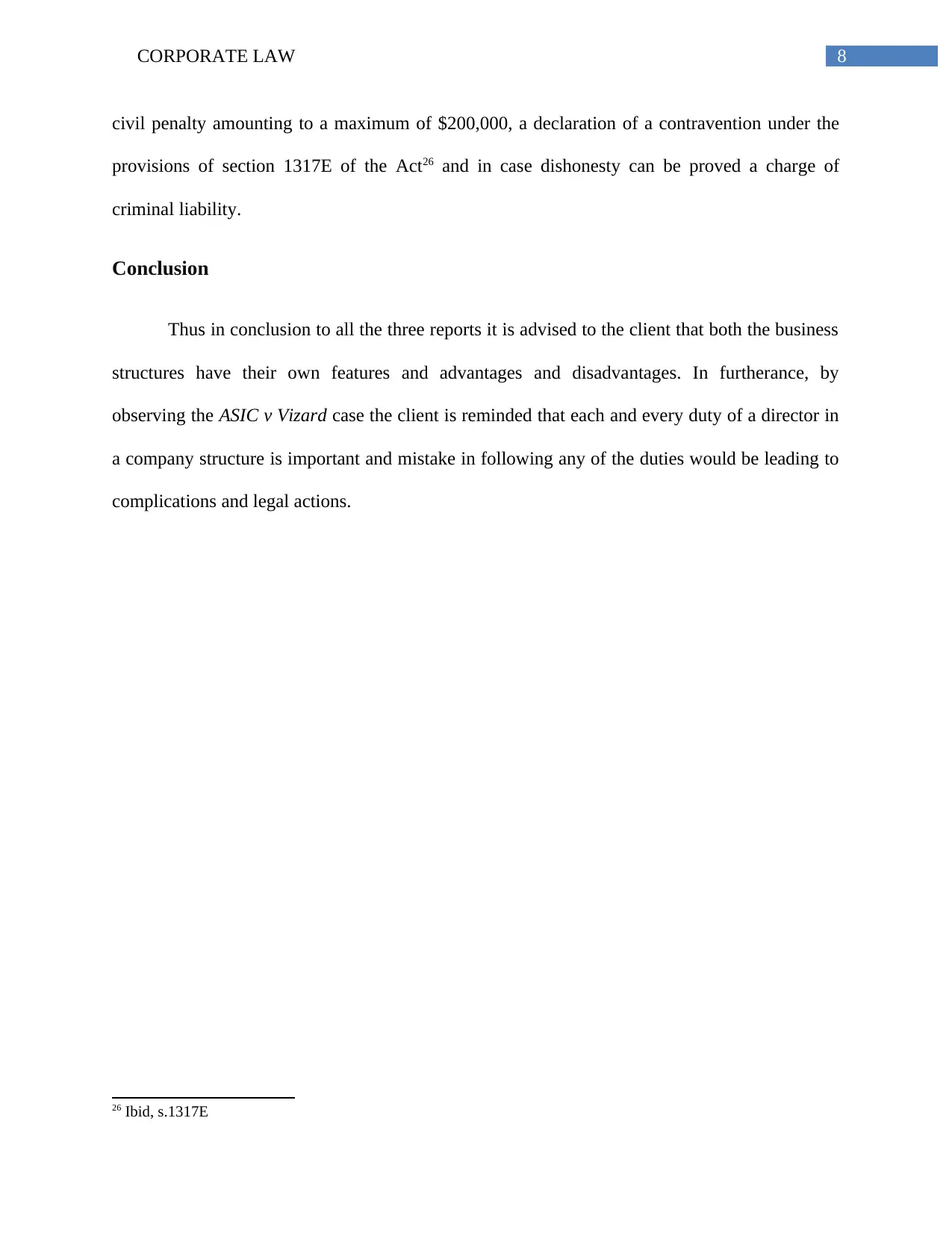
8CORPORATE LAW
civil penalty amounting to a maximum of $200,000, a declaration of a contravention under the
provisions of section 1317E of the Act26 and in case dishonesty can be proved a charge of
criminal liability.
Conclusion
Thus in conclusion to all the three reports it is advised to the client that both the business
structures have their own features and advantages and disadvantages. In furtherance, by
observing the ASIC v Vizard case the client is reminded that each and every duty of a director in
a company structure is important and mistake in following any of the duties would be leading to
complications and legal actions.
26 Ibid, s.1317E
civil penalty amounting to a maximum of $200,000, a declaration of a contravention under the
provisions of section 1317E of the Act26 and in case dishonesty can be proved a charge of
criminal liability.
Conclusion
Thus in conclusion to all the three reports it is advised to the client that both the business
structures have their own features and advantages and disadvantages. In furtherance, by
observing the ASIC v Vizard case the client is reminded that each and every duty of a director in
a company structure is important and mistake in following any of the duties would be leading to
complications and legal actions.
26 Ibid, s.1317E
⊘ This is a preview!⊘
Do you want full access?
Subscribe today to unlock all pages.

Trusted by 1+ million students worldwide
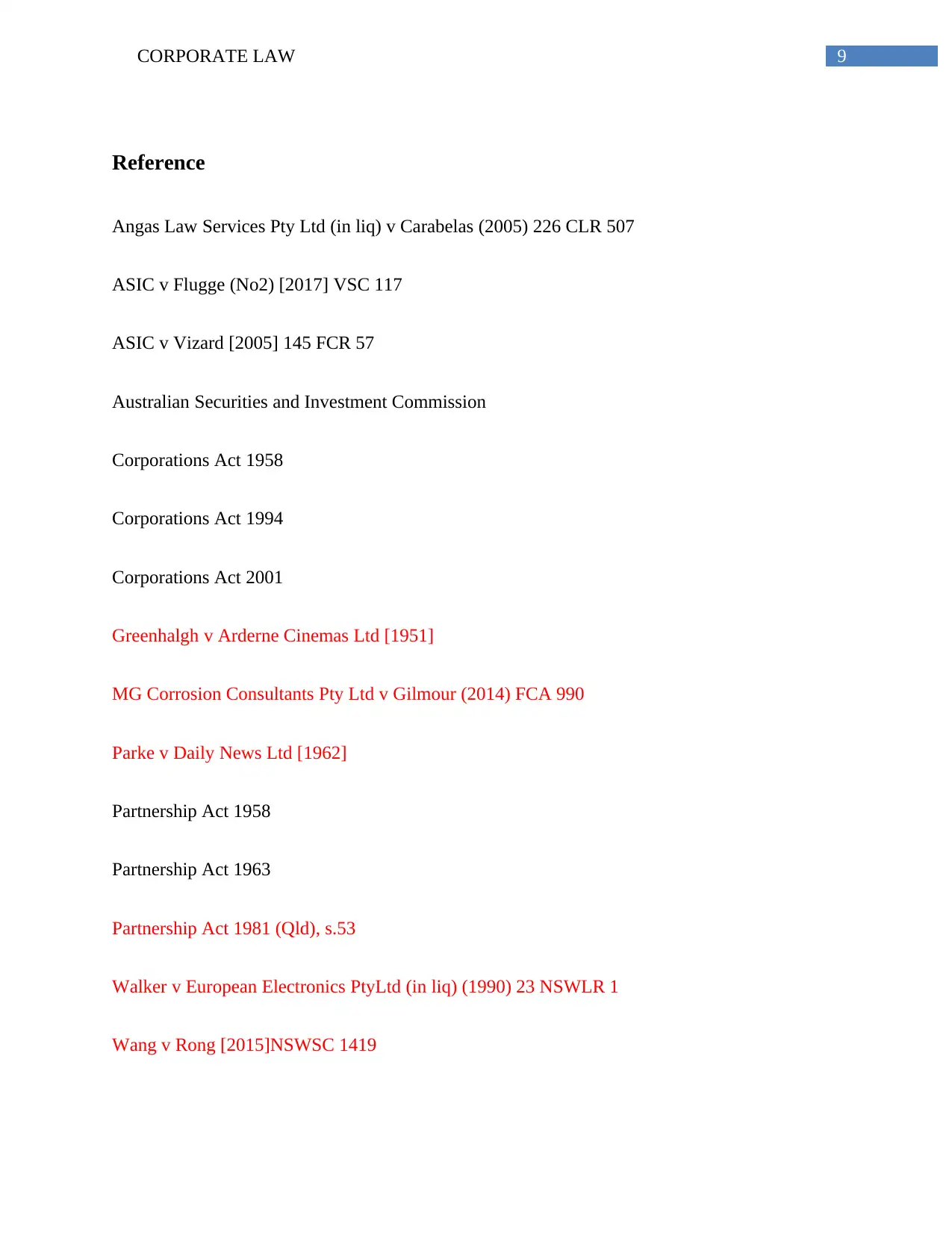
9CORPORATE LAW
Reference
Angas Law Services Pty Ltd (in liq) v Carabelas (2005) 226 CLR 507
ASIC v Flugge (No2) [2017] VSC 117
ASIC v Vizard [2005] 145 FCR 57
Australian Securities and Investment Commission
Corporations Act 1958
Corporations Act 1994
Corporations Act 2001
Greenhalgh v Arderne Cinemas Ltd [1951]
MG Corrosion Consultants Pty Ltd v Gilmour (2014) FCA 990
Parke v Daily News Ltd [1962]
Partnership Act 1958
Partnership Act 1963
Partnership Act 1981 (Qld), s.53
Walker v European Electronics PtyLtd (in liq) (1990) 23 NSWLR 1
Wang v Rong [2015]NSWSC 1419
Reference
Angas Law Services Pty Ltd (in liq) v Carabelas (2005) 226 CLR 507
ASIC v Flugge (No2) [2017] VSC 117
ASIC v Vizard [2005] 145 FCR 57
Australian Securities and Investment Commission
Corporations Act 1958
Corporations Act 1994
Corporations Act 2001
Greenhalgh v Arderne Cinemas Ltd [1951]
MG Corrosion Consultants Pty Ltd v Gilmour (2014) FCA 990
Parke v Daily News Ltd [1962]
Partnership Act 1958
Partnership Act 1963
Partnership Act 1981 (Qld), s.53
Walker v European Electronics PtyLtd (in liq) (1990) 23 NSWLR 1
Wang v Rong [2015]NSWSC 1419
Paraphrase This Document
Need a fresh take? Get an instant paraphrase of this document with our AI Paraphraser

10CORPORATE LAW
1 out of 11
Related Documents
Your All-in-One AI-Powered Toolkit for Academic Success.
+13062052269
info@desklib.com
Available 24*7 on WhatsApp / Email
![[object Object]](/_next/static/media/star-bottom.7253800d.svg)
Unlock your academic potential
Copyright © 2020–2025 A2Z Services. All Rights Reserved. Developed and managed by ZUCOL.





